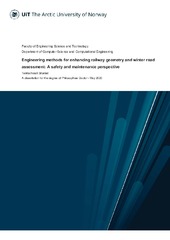| dc.contributor.advisor | Corner, Geoffrey D. | |
| dc.contributor.advisor | Bergh, Steffen G. | |
| dc.contributor.advisor | Lauknes, Tom Rune | |
| dc.contributor.author | Eriksen, Harald Øverli | |
| dc.date.accessioned | 2013-07-01T11:19:32Z | |
| dc.date.available | 2013-07-01T11:19:32Z | |
| dc.date.issued | 2013-05-15 | |
| dc.description.abstract | Norway is particularly susceptible to large rockslides due to its many fjords and steep mountains. One of the most dangerous hazards related to rock slope failures are tsunamis that can lead to large loss of life. Many rockslides are clustered east of the Storfjord and Lyngen fjord in Troms county, northern Norway, where several mapped unstable rock slopes occur within the zone of sporadic permafrost. Among these, the Nordnes rockslide has been classified as high-risk due to the severe consequences should catastrophic failure occur.
In order to fully understand the kinematics and geometric configurations susceptible for sliding, it is imperative to obtain precise measurements of the stability of potential unstable rock slopes.
Multi-temporal satellite interferometric synthetic aperture radar (InSAR) techniques involve comparing the phase information from multiple spaceborne SAR images, produced at different times, to detect millimeter to centimeter scale ground deformation patterns. However, the satellite radar is only capable of measuring displacement that has a component in the radar line-of-sight (LOS). By combining InSAR data acquired in both ascending and descending orbits, it is possible to extract more information about the true displacement vector, increasing the interpretability of the displacement patterns.
In this thesis, multi-temporal InSAR methods are applied to an extensive time series of TerraSAR-X data collected in both ascending and descending geometries during the summer seasons in the period 2009-2012. The estimated deformation rates from the ascending and descending geometries are decomposed into 2D InSAR data consisting of deformation in the vertical and east/west directions, dip angle and total displacement. The computed 2D InSAR displacement data are validated with GPS data from the Nordnes rockslide.
For the study area, the 2D InSAR are related to geomorphological- and structural elements in different slope processes; a rock glacier, solifluction tongues, a fast moving rockslide (Gamanjunni3) and the Nordnes rockslide.
Findings suggest that 2D InSAR data give a more adequate and comprehensible presentation of displacement in slope processes, with increased sensitivity to displacement. Produced 2D InSAR data show numerous examples of correlation between geomorphological- and structural elements and pattern observed in the 2D InSAR data. This includes identifying elements like solifluction tongues, outer extents of and ridge formations on rock glaciers, back fractures, fractures separating blocks and lateral borders of rockslides. 2D InSAR data have the possibility to enlighten the inner dynamics of slope processes. E.g. make prediction about displacement patterns for blocks, to what extent they are fragmenting or moving as one body and to what extent the displacement pattern in a slope process are controlled by the slope gradient. Displacement patterns originating from rotation of fault blocks, caused by a listric detachment fault or toe-zone compression uplifting the front of the fault block (thrust duplex) have been observed. There are good indications that 2D InSAR data can contribute to classification of slides, revealing listric of planar fault geometry and to state the controlling factors of rockslides. | en |
| dc.identifier.uri | https://hdl.handle.net/10037/5240 | |
| dc.identifier.urn | URN:NBN:no-uit_munin_4953 | |
| dc.language.iso | eng | en |
| dc.publisher | Universitetet i Tromsø | en |
| dc.publisher | University of Tromsø | en |
| dc.rights.accessRights | openAccess | |
| dc.rights.holder | Copyright 2013 The Author(s) | |
| dc.rights.uri | https://creativecommons.org/licenses/by-nc-sa/3.0 | en_US |
| dc.rights | Attribution-NonCommercial-ShareAlike 3.0 Unported (CC BY-NC-SA 3.0) | en_US |
| dc.subject.courseID | GEO-3900 | en |
| dc.subject | VDP::Matematikk og Naturvitenskap: 400::Geofag: 450::Faste jords fysikk: 451 | en |
| dc.subject | VDP::Mathematics and natural science: 400::Geosciences: 450::Solid earth physics: 451 | en |
| dc.subject | VDP::Matematikk og Naturvitenskap: 400::Geofag: 450::Naturgeografi: 455 | en |
| dc.subject | VDP::Mathematics and natural science: 400::Geosciences: 450::Physical geography: 455 | en |
| dc.subject | VDP::Matematikk og Naturvitenskap: 400::Geofag: 450::Tektonikk: 463 | en |
| dc.subject | VDP::Mathematics and natural science: 400::Geosciences: 450::Tectonics: 463 | en |
| dc.subject | VDP::Teknologi: 500::Berg- og petroleumsfag: 510::Geoteknikk: 513 | en |
| dc.subject | VDP::Technology: 500::Rock and petroleum disciplines: 510::Geological engineering: 513 | en |
| dc.subject | VDP::Matematikk og Naturvitenskap: 400::Informasjons- og kommunikasjonsvitenskap: 420::Simulering, visualisering, signalbehandling, bildeanalyse: 429 | en |
| dc.subject | VDP::Mathematics and natural science: 400::Information and communication science: 420::Simulation, visualization, signal processing, image processing: 429 | en |
| dc.subject | VDP::Matematikk og Naturvitenskap: 400::Geofag: 450::Kvartærgeologi, glasiologi: 465 | en |
| dc.subject | VDP::Mathematics and natural science: 400::Geosciences: 450::Quaternary geology, glaciology: 465 | en |
| dc.title | Slope displacement patterns observed using satellite InSAR data in the Storfjord-Kåfjord-Lyngen region, Troms | en |
| dc.type | Master thesis | en |
| dc.type | Mastergradsoppgave | en |


 English
English norsk
norsk



